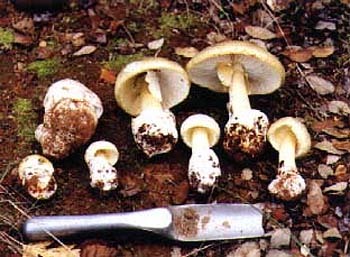Introduction
In 1918, in Poznan, Poland, 31 children died after eating a mushroom meal prepared for them by their school. They had eaten the deadly deathcap mushrooms (Amanita phalloides). Deathcaps now grow in Australia. They are thought to have been imported inadvertently from the USA attached to the roots of oak trees. Deathcaps are found mainly in the Australian Capital Territory, but are spreading and have been reported in Victoria.
Deathcaps contain a toxin, amatoxin, that inhibits protein synthesis. This toxin is not inactivated by cooking, freezing or drying. There are four clinical phases of poisoning:
– phase I - asymptomatic latent period lasting up to 24 hours
– phase II - watery diarrhoea
– phase III - symptoms temporarily resolve
– phase IV - hepatic and renal failure
Death can occur within 7-10 days after ingestion of a single cap in adults. The overall mortality is about 20%.
Treatment
The initial management of the poisoning includes vigorous gastrointestinal decontamination with activated charcoal and whole bowel irrigation. Retrospective clinical studies and animal studies support the use of high-dose penicillin (0.5-1 million units/kg/day) and silibinin (an extract of the milk thistle available only in Europe). Both penicillin and silibinin are thought to act by inhibiting the uptake of the amatoxin into hepatocytes and interfering with its enterohepatic circulation. Liver transplantation is recommended for patients who fail to respond to more conservative measures. Although liver transplantation has not yet been performed in Australia for deathcap poisoning, it has been successfully carried out in the USA since 1985.
Prevention
There are no simple and effective treatments for deathcap poisoning so increased community and clinician awareness is needed to reduce the incidence of poisonings and improve outcomes. Currently, the level of knowledge about deathcap poisonings in Australia is limited. In our series of seven accidental poisonings, the diagnosis was not made on initial presentation to hospital in five cases. Deathcap poisoning was not suspected at all in one case, despite a history of eating mushrooms and a characteristic clinical picture.1
In most cases of poisoning, the mushrooms have been picked in the wild and eaten by people who cannot tell the difference between deathcap mushrooms and edible mushrooms. Deathcap mushrooms are the fruit of a fungus that grows in the root systems of trees, especially oak trees. Amanita phalloides has a white to white-green cap with white gills and a cup (volva) at the base of the stem (see picture).
|
Amanita phalloide
 Picture provided by Mr Richard Windsor
|
Anyone who cannot differentiate edible mushrooms from deathcaps should never pick and eat wild mushrooms. Even so, it has been pointed out that any mushroom is edible ... once!